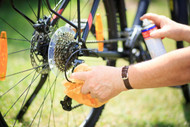How to Clean a Bike: Keeping Your Ride in Top Shape
Posted by 1UP USA on Oct 5th 2025

HOW TO CLEAN A BIKE: KEEPING YOUR RIDE IN TOP SHAPE
Keeping your bike clean isn't just about making it look good (though that's a nice bonus). Regular bike cleaning keeps your components running smoothly, extends the life of your bike parts, and helps you spot potential problems before they become expensive repairs. Plus, there's something satisfying about a spotless ride that makes every adventure feel a little more special.
Whether you ride a mountain bike through muddy trails or cruise a road bike along smooth pavement, this guide will walk you through everything you need to know about proper bike washing and maintenance.
WHY REGULAR BIKE CLEANING MATTERS
Your bike works hard for you, and dirt, grime, and road salt can wreak havoc on its components. Chain lube gets contaminated, brake pads wear unevenly, and drivetrain components suffer when particles grind against moving parts. A clean bike is a happy bike that shifts smoothly, brakes reliably, and rolls efficiently.
Think of bike cleaning as preventive medicine for your ride. Spending 30 minutes washing your bike after a few rides beats spending hundreds at the local bike shop for premature part replacements.
WHAT YOU'LL NEED: BUILDING YOUR BIKE CLEANING ARSENAL
Before diving into the cleaning process, gather these supplies. You don't need to break the bank, but having the right tools makes the job easier and more effective.
BASIC CLEANING SUPPLIES
Item | Purpose | Notes |
Bike cleaner or dish soap | General cleaning | Bike cleaner works great, but gentle dish soap is fine |
Spray bottle | Applying cleaning solution | Mix your own solution with soap or buy pre-mixed to pour into the spray bottle |
Soft-bristled brush | Scrubbing frame and components | Won't scratch delicate surfaces |
Cleaning brush (firm) | Cleaning drivetrain and stubborn dirt | Look for quality brush sets at bike shops or online |
Bottle brush | Htting hard-to-reach areas | Perfect for bottle cages and tight spots |
Microfibre cloth | Drying and polishing | Multiple cloths work best |
Clean rag or old rag | General wiping | Keep several handy |
Paper towel | Final details | For precision work |
SPECIALIZED TOOLS
• Chain cleaning tool: Makes cleaning the whole chain much easier
• Specific brush set: Different brushes for different jobs
LUBRICATION SUPPLIES
• Chain lube: Dry lube for dusty conditions and wet lube for wet weather
• General bike lubricant: For pivot points and cables
STEP-BY-STEP BIKE CLEANING PROCESS
STEP 1: SET UP YOUR WORKSPACE
Find a shaded area with good drainage. Direct sunlight causes cleaning products to dry too quickly, leaving streaks and residue. If you're washing indoors, lay down some old towels to protect your floor.
Position your bike in a work stand if you have one; It keeps your bike stable and makes cleaning much easier. If you don’t have a stand, you can flip your bike upside down or lean it securely, but be careful not to stress the brake levers or derailleur. Some cyclists prefer to keep the bike upright and work around it.
STEP 2: INITIAL RINSE
Start with a gentle rinse using warm water from a garden hose or bucket. Avoid high-pressure water that can force dirt into bearings or damage delicate components like the bottom bracket or headset.
Pay special attention to the drivetrain, where most of the grime accumulates. A quick rinse helps remove loose dirt and makes the actual cleaning more effective.
STEP 3: APPLY YOUR CLEANING SOLUTION
Mix your bike cleaner according to package directions, or create a simple solution with warm water and a few drops of dish soap in your spray bottle. Avoid harsh detergents that can damage paint or components.
Spray the entire bike, focusing on dirty areas. Let the solution sit for a few minutes to break down stubborn grime, but don't let it dry completely.
STEP 4: CLEAN THE FRAME
Using your soft-bristled brush and soapy water, work from top to bottom. Start with the frame, paying attention to areas where dirt collects, like the bottom bracket area and behind the seat tube.
For carbon fiber frames, be extra gentle. These bikes need careful handling to avoid damage to the frame material. A microfibre cloth often works better than brushes on carbon fiber.
STEP 5: TACKLE THE DRIVETRAIN
This is where the magic happens. Your chain, cassette, and chainrings need special attention since they deal with the most stress and collect the most dirt.
Cleaning the Chain
If you have a chain cleaning tool, fill it with degreaser and run the chain through several times. For those who don’t, use a cleaning brush and work along the whole chain while slowly turning the pedals backward.
For a dirty chain, don't be afraid to really scrub. A clean chain is the foundation of smooth shifting and efficient pedaling.
Cleaning Other Drivetrain Components
• Cassette: Use a specific brush to get between the cogs
• Chainrings: Scrub both sides, paying attention to the teeth
• Derailleur: Carefully clean around the pulleys and pivot points
• Bottom bracket area: Scrub thoroughly as dirt accumulates here
STEP 6: BRAKE SYSTEM CARE
Your braking system needs special attention for both performance and safety. Contaminated brake pads or dirty braking surfaces reduce stopping power and cause squealing noises.
Rim Brakes
Clean the braking surface on your rims with a clean rag and some degreaser. Check your brake pads for embedded debris that could scratch your rims.
Disc Brakes
Be careful around disc brake rotors. Use a specific brush and avoid getting any lube or soap on the braking surface. Clean brake pads should never contact contaminated rotors.
STEP 7: WHEELS AND TIRES
Clean your wheels inside and out. Check for embedded glass or debris in your tires while you're at it. A bottle brush works well for getting dirt out of hard-to-reach spoke areas.
STEP 8: FINAL RINSE
Rinse everything thoroughly with clean water. Take your time here; Soap residue can attract dirt and cause premature wear on moving parts.
STEP 9: DRY AND INSPECT
Use clean microfibre cloths or paper towels to dry your bike completely. This is a great time to inspect your bike for any issues like loose bolts, worn brake pads, or cable problems.
Pay special attention to areas where water can pool, like the bottom bracket or inside the frame (if you have drain holes).
LUBRICATION: THE FINAL TOUCH
Once your bike is completely dry, it's time to lubricate the moving parts. Apply chain lube sparingly to your clean chain, running it through all the gears to distribute it evenly. Wipe off excess lube with a clean rag. Having too much attracts dirt.
Other areas that benefit from lubrication:
• Derailleur pivot points
• Brake and shifter cables
• Pedal threads (during reassembly)
Choose your lube based on conditions:
• Dry lube for dusty environments
• Wet lube for rainy weather.
SPECIAL CONSIDERATIONS FOR DIFFERENT BIKE TYPES
MOUNTAIN BIKES
Mountain bikes face the toughest conditions and need more frequent cleaning. After muddy rides, at least rinse off the worst dirt to prevent it from hardening. Pay extra attention to suspension components and keep dirt away from seals.
ROAD BIKES
Road bikes might look cleaner, but road grime and salt (in winter) can be just as damaging as trail dirt. Clean more frequently during winter months when roads are salted.
ELECTRIC BIKES
Be extra careful around electrical components. Many modern e-bikes handle water well, but avoid direct spray on battery connections and control units. Check your manual for specific cleaning guidelines.
HOW OFTEN SHOULD YOU CLEAN YOUR BIKE?
The frequency of cleaning depends on where and how often you ride:
• After every muddy or dusty ride, rinse off major dirt right away to prevent buildup.
• Every 2–4 rides for mountain bikes, especially after trail rides with mud, dust, or sand.
• Every 20–25 rides for road bikes, or monthly, whichever comes first, especially in salty or grimy road conditions.
• Every 100–200 miles for chains. Wipe clean and re-lube for better performance.
• Seasonal deep clean: Do a full inspection and overhaul at the start and end of each major riding season.
Listen to your bike. If it sounds gritty when shifting or pedaling, it's time for a cleaning session.
BIKE CLEANING MISTAKES TO AVOID
USING THE WRONG PRODUCTS
Avoid household cleaners, especially anything with ammonia or bleach. Stick to bike-specific cleaners or gentle dish soap. Never use a pressure washer or car wash; The high pressure can damage bearings and seals.
NEGLECTING THE DRIVETRAIN
Your drivetrain works the hardest and gets the dirtiest. Skipping this area means poor shifting and premature wear.
OVER-LUBRICATION
More isn't better when it comes to lube. Excess lubricant attracts dirt and creates a grinding paste that wears components faster.
CLEANING IN DIRECT SUN
Heat causes cleaning products to dry too quickly, leaving residue that's harder to remove than the original dirt.
BUILDING GOOD CLEANING HABITS
Even if you're short on time, a quick post-ride routine can keep your bike in great shape. Keep a spray bottle and microfibre cloth handy for quick cleanups.
• Wipe the chain with a clean rag after each ride to remove surface grime
• Check tire pressure and wipe down tires if they've picked up debris
• Brush off visible dirt or dust with a soft cloth or brush
These small habits can help you stretch the time between full washes and prevent damage from buildup.
WHEN TO SEEK PROFESSIONAL HELP
While most bike cleaning can be done at home, some situations call for professional attention:
• Deep carbon fiber frame cleaning
• Suspension service
• Internal cable routing issues
• Hydraulic brake bleeding
• Bottom bracket or headset bearing service
Your local bike shop has specialized tools and expertise for complex maintenance tasks.
KEEP YOUR INVESTMENT ROLLING SMOOTHLY
Regular bike cleaning isn't just maintenance, it's an investment in your riding experience and your bike's longevity. A well-maintained bike responds better, lasts longer, and keeps you safer on every ride.
After you've put time and care into keeping your bike in perfect condition, make sure you're transporting it safely. When you're ready to take your bike on new adventures, 1UP USA is there for you. Our American-made bike racks are built to the same quality standards you apply to your bike maintenance. Racks designed to last a lifetime with replaceable parts and constructed from materials won't let you down. Just like a well-maintained bike, a quality rack protects your investment and gets you to your next adventure safely. Check out our full bike rack collection today!




